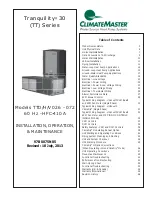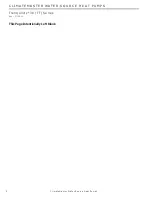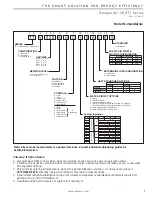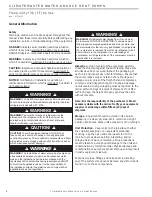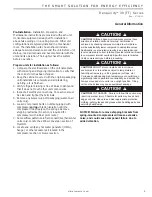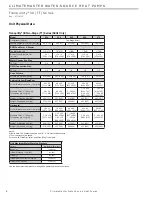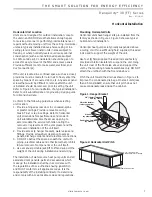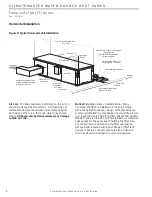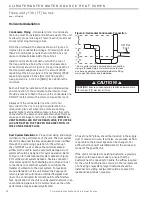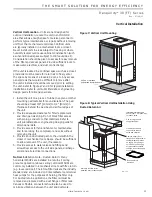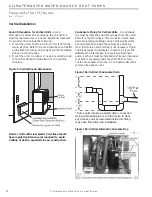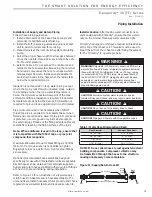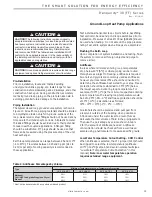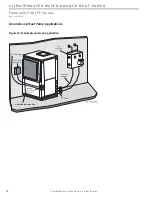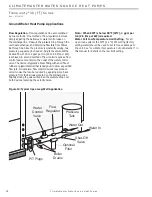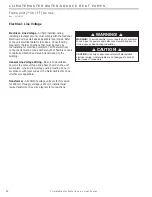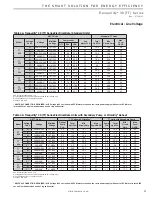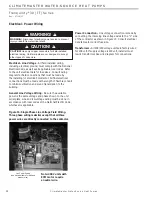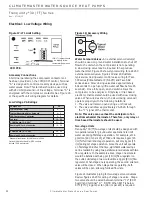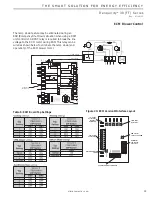
15
c l i m a t e m a s t e r. c o m
T H E S M A R T S O L U T I O N F O R E N E R G Y E F F I C I E N C Y
Tr a n q u i l i t y
®
3 0 ( T T ) S e r i e s
R e v. : 0 7 / 1 8 / 1 3
Ground-Loop Heat Pump Applications
Pre-Installation
Prior to installation, locate and mark all existing
underground utilities, piping, etc. Install loops for new
construction before sidewalks, patios, driveways, and other
construction has begun. During construction, accurately
mark all ground loop piping on the plot plan as an aid in
avoiding potential future damage to the installation.
Piping Installation
The typical closed loop ground source system is shown in
Figure 13. All earth loop piping materials should be limited
to polyethylene fusion only for in-ground sections of the
loop. Galvanized or steel fi ttings should not be used at any
time due to their tendency to corrode. All plastic to metal
threaded fi ttings should be avoided due to their potential
to leak in earth coupled applications. A fl anged fi tting
should be substituted. P/T plugs should be used so that
fl ow can be measured using the pressure drop of the unit
heat exchanger.
Earth loop temperatures can range between 25 and 110°F
[-4 to 43°C]. Flow rates between 2.25 and 3 gpm [2.41 to
3.23 l/m per kW] of cooling capacity is recommended in
these applications.
Test individual horizontal loop circuits before backfi lling.
Test vertical U-bends and pond loop assemblies prior to
installation. Pressures of at least 100 psi [689 kPa] should
be used when testing. Do not exceed the pipe pressure
rating. Test entire system when all loops are assembled.
Flushing the Earth Loop
Upon completion of system installation and testing, fl ush
the system to remove all foreign objects and purge to
remove all air.
Antifreeze
In areas where minimum entering loop temperatures
drop below 40°F [5°C] or where piping will be routed
through areas subject to freezing, antifreeze is required.
Alcohols and glycols are commonly used as antifreeze;
however your local sales offi ce should be consulted to
determine the antifreeze best suited to your area. Freeze
protection should be maintained to 15°F [9°C] below
the lowest expected entering loop temperature. For
example, if 30°F [-1°C] is the minimum expected entering
loop temperature, the leaving loop temperature would
be 22 to 25°F [-6 to -4°C] and freeze protection should be
at 15°F [-10°C]. Calculation is as follows:
30°F - 15°F = 15°F [-1°C - 9°C = -10°C].
All alcohols should be premixed and pumped from
a reservoir outside of the building when possible or
introduced under the water level to prevent fumes.
Calculate the total volume of fl uid in the piping system.
Then use the percentage by volume shown in table
2 for the amount of antifreeze needed. Antifreeze
concentration should be checked from a well mixed
sample using a hydrometer to measure specifi c gravity.
CAUTION!
The following instructions represent industry
accepted installation practices for closed loop earth coupled
heat pump systems. Instructions are provided to assist the
contractor in installing trouble free ground loops. These
instructions are recommendations only. State/provincial
and local codes MUST be followed and installation MUST
conform to ALL applicable codes. It is the responsibility of
the installing contractor to determine and comply with ALL
applicable codes and regulations.
Table 2: Antifreeze Percentages by Volume
Low Water Temperature Cutout Setting - CXM Control
When antifreeze is selected, the LT1 jumper (JW3) should
be clipped to select the low temperature (antifreeze
10.0°F [-12.2°C]) setpoint and avoid nuisance faults (see
“Low Water Temperature Cutout Selection” in this
manual).
Note: Low water temperature operation
requires extended range equipment.
CAUTION!
CAUTION!
Type
Minimum Temperature for Low Temperature Protection
10°F [-12.2°C]
15°F [-9.4°C]
20°F [-6.7°C]
25°F [-3.9°C]
Methanol
100% USP food grade Propylene Glycol
Ethanol*
25%
38%
29%
21%
25%
25%
16%
22%
20%
10%
15%
14%
CAUTION!
Ground loop applications require extended range
equipment and optional refrigerant/water circuit insulation.
* Must not be denatured with any petroleum based product

